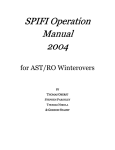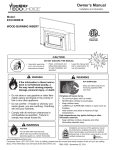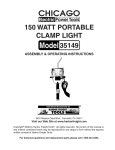Download User Guide for Ingenium & Integrum v4
Transcript
User Guide for Ingenium and Integrum loudspeakers Teresonic 1215 Fiddlers Green • San Jose, 95125 California, USA Phone 408.973.8813 • www.teresonic.com Teres: rounded, polished, smooth, fine, elegant in Latin Table of Contents C H A P T E R 1 INTRODUCTION C H A P T E R 1 New life for your music yet perfectly natural 5 ROOM ACOUSTICS 11 Improve the sound stage & image depth 11 1 Big performance even at 4 Watts per channel 2 Exceptionally detailed and clean sound 2 Getting fast, tight, realistic bass 12 Improve musical detail 12 Improve bass in your system 13 Designed & handcrafted to endure the test C H A P T E R of time TECHNICAL SPECIFICATIONS 14 Integrum technical specifications 14 Ingenium technical specifications 15 C H A P T E R 3 2 UNPACKING INSTRUCTIONS 4 Contents 4 C H A P T E R 3 C H A P T E R 6 7 WARRANTY AND SERVICE 16 In the unlikely event of a problem 16 INSTALLATION AND WIRING 5 Warranty Statement 17 Wiring 5 Final Instructions 18 Installation and operation 5 Installation of Lowther drivers (optional) 6 Important! Brake-in period 7 C H A P T E R 4 FINE TUNING 8 Speaker Placement 8 Positioning (Toe-In) 8 Room acoustics and corner treatment 9 Taking Care of Your Speakers 10 D E S I G N C U S T O M I Z A T I O N Chapter 1 Introduction Congratulations on making the investment in Teresonic speakers that will enable the musical reality of a concert hall or a jazz club transferred to your listening room. T eresonic Audio speakers are designed to produce the most natural sound of exceptional clarity and levels of detail, neutrality and stereo imaging that are beyond anything else in their category. That is accomplished using unique and very advanced acoustic design, finest components and materials available, and by avoiding every unnecessary component or gimmick that can introduce sound coloration, interference or distortion – leading to musical reality of a concert hall or a jazz club transferred to your listening room. New life for your music yet perfectly natural Every sound source in nature is “punctual” radiating sound waves around them – whether it’s a violin, a trumpet, or a human voice. Teresonic speakers follow that basic design rule of the Nature. Multi-driver designs introduce multiple interfering sound sources (speaker drivers in the cabinet) which lead to complex and unpredictable cancellations and reinforcements between sound waves – leading to sound colorations and distortions. Teresonic one-way speaker design using full range high-efficiency drivers, provides natural sound with a wealth of detail, exceptional dynamic range and a sense of musical “livens” that you don’t often hear elsewhere. The challenge is to make speakers that we can call transcendental - something that breaks boundaries and creates emotion, but keeping sound natural and intact, as it was in the concert hall or recording studio. Teresonic speakers operate legendary Lowther full-range speakers without any electrical components such as filters or crossovers between the amplifiers and the speakers. Conventional designs put a crossover in the midrange to split the signal to the bass driver and the tweeter. This is exactly the region where our hearing is most sensitive. These crossovers introduce phase and balance problems that cause deterioration in detail, transparency and imaging. Even worse, most speakers go from a cone driver for the bass to a tweeter with totally different sonic characteristics, such as a dome or ribbon tweeter, for the treble. The ability of the Teresonic speakers to speak across the full frequency spectrum with one voice, and with such speed and lack of coloration, makes them seem all the more electrostatic. In the end, however, Teresonic speakers will play much louder than all except the largest electrostatic speakers and they will best any electrostatics in bass power and dynamic wallop. You can hit these speakers with hard transients and they not 1 D E S I G N C U S T O M I Z A T I O N only do not flinch, they start and stop on a dime and deliver the full frequency and dynamic range of the signal. It is actually kind of hard to truly convey the full abilities of these speakers. Teresonic speakers so well pass on the sonic thumbprints of the rest of the components in the system that they themselves tend to be pretty chameleon-like in their own sound. Big performance even at 4 Watts per channel The high sensitivity of Teresonic speakers enables low power amplifiers, or high power amplifiers operated at low power levels, to achieve realistic sound levels in all but the largest rooms. The Teresonic will sound outstanding and play plenty loudly with an 8 wpc 300B-based tube stereo amplifier, as well as a 25 wpc 845based tube amplifier, or any other SET designs. They also sound excellent, if not as totally pure and direct as when partnered with the single-ended models, powered by a set of the push-pull monoblocs that are rated at 100 wpc. With Teresonic speakers even sonic “gems” such as 2A3-based amplifiers will deliver big performance, they will come to life and deliver extraordinary musical reality even at few Watts of power. If 1 watt is good for 102 db, then 4 watts are good for a peak output of about 108 db and 8 watts of about 111 db at one meter distance - and with the lowest distortion you have ever heard in a loudspeaker. Higher power solid-state amplifiers will benefit from operating on low power levels where the distortions are lowest – or almost non-existent. Despite manufacturers “paper specifications” even the finest high-end amplifiers will introduce some sound distortions and colorations when played at high power levels. This is simply driven by laws of physics and various components’ characteristics that are different at different load levels. Higher the load, more stress on the component, more difficult for designer to get perfect results – even harder at the high end. The simple solution is to operate at lower power levels and enjoy your music unspoiled, as it was created in its natural environment, and still have a big performance of concert hall. Exceptionally detailed and clean sound ETQWT© (Enhanced Tapered Quarter Wave Tube) transmission line design, the result of some 20 years of research and experimentation, is the key for Teresonic speakers’ extremely clean and accurate midrange, the widest range of sound audible to our ears, and extended low frequency response – up to one-half octave below the fundamental resonance of the driver. It is also the simplest, purest, most uncolored approach to design a system which allows the speaker drivers to operate in "free air," duplicating the motion of sound waves emanating from both sides of a musical instrument in live performance. This, however, is extremely difficult to achieve as any dynamic speaker with a cabinet has to manipulate the back-wave of the driver. In a sealed-box design, you’re tuning against a certain air pressure to obtain a certain response characteristic. In a vented box, you employ resonances to achieve a lower cutoff frequency. The only box where you have the same air pressure behind the driver as in front is the transmission line. The transmission line is a long folded or unfolded passageway designed to be 1/4-wavelength long at the free air resonance frequency of the driver, so that the acoustical output radiated from the line opening mixes with the front-wave from the driver, to cause partial cancellation of the signal, only at the resonance frequency. This technique leaves the driver free to accelerate and decelerate with ease, except at the resonance frequency where its motion is inhibited. This "frequency-selective damping" quality is largely responsible for the superior sound 2 D E S I G N C U S T O M I Z A T I O N quality of properly designed and implemented transmission line systems, including Teresonic Ingenium and Integrum loudspeakers. Fine tuning for the perfect end results is accomplished with Helmholtz resonators designed for picking out particular frequencies from a complex sound. They are purely acoustical, rather than electronic elements, responsible for exceptionally smooth response of Teresonic speakers without distortions and unwanted colorations. Designed & handcrafted to endure the test of time Form follows function and our enclosures tend to be very attractive, sculpture-like shapes – a welcome addition to any room. Any way you consider them – as a piece of art that sounds great or great sounding speakers in an eye pleasing package, Teresonic speakers are built entirely by hand to highest standards using the finest materials available. High gloss finish, applied in several layers of highest-quality varnish, enhances natural wood veneer and superb craftsmanship that one may expect from the finest cabinet makers and speakers costing many thousands more. True high end speakers such as Teresonic, need top quality drive units. We use the top of the line DX-series of legendary Lowther drivers, considered the Rolls-Royce of the speaker industry, that are still literally hand-made by Lowther-Voigt Ltd in England. They incorporate extremely powerful magnets of 2 Tesla or more and ultra-light paper cones, leading to extraordinary sensitivity, transient response, and low distortion. They are possessed of a stunning sense of aliveness and vitality, and have a degree of sonic invisibility that is both seductive and addictive. Many high-end speakers on the market will use standard wiring inside the box between drivers and connectors in the back of the box. Not so with Teresonic speakers that are equipped with the world best WBT connectors and the same high-end Clarison cables inside the box that are offered to connect to your amplifier. Matching speaker cables and wiring inside the box is also important to maintain the same sonic character in the entire audio chain – from your amplifier to the speaker and the drive-unit. 3 Chapter 2 Unpacking Instructions Important! Before you start unpacking, inspect the outer carton for any signs of shipping damage. If you see or suspect that there is damage, inform the seller as soon as possible. Y our Teresonic Ingenium speakers were shipped in heavy-duty wooden crates for safe transportation. It is recommended that you save the crates and other packing material such as cotton bags that are protecting the fine lacquer on your speakers for possible future use. Due to the weight of the speakers, it is highly recommended to have two people to un-crate them and position them for listening. After taking the speaker out of the crate, untie the cotton bag at the bottom of the speaker and the bag can be slid off the top. Your Integrum speakers are shipped in cartons. If the shipping carton looks intact, proceed as follows: Gently turn the box upside-down, and open the bottom end of the shipping carton, folding the four bottom flaps outward. Now, holding the inner packing material in place, tip the box over onto the open bottom end, and simply lift the carton away. Be sure to save the cartons and all packing materials. At this time, please fill out the warranty card on the internet (www.teresonic.com/warranty), putting both serial numbers and the date of purchase on the card. The serial numbers are on the rear of the speakers below the input terminals and on your invoice. Contents The shipping crates (always shipped in pairs) contain the following items: 1)Loudspeakers, 2)Removable grille assemblies, 3)The owner’s manual, and 4)Adjustable spikes and floor discs It is extremely important that the Teresonic floor standing loudspeakers are correctly fitted with the provided spikes to ensure speaker stability. Remember to tighten the locknut well once you have adjusted the height of the four spikes. It is also important to use the provided floor discs underneath the spikes in order to ensure that there is no damage to the floor. This is especially important for hardwood and similar floors. For optimal results use Teresonic “zero interference” Clarison speaker cables to connect the loudspeakers with your amplifier. The same ultra-high quality Clarison cables are used inside the speaker cabinet to connect speaker terminals in the back of the speaker to the speaker driver. Using the same cables will ensure the same character of the sound and the best overall sonic quality without coloration or distortions. 4 Chapter 3 Installation and Wiring Before making any connections always turn off your amplifier. Installing and wiring your speakers is an easy and straightforward process. Enjoy your new Teresonic sound! Y our speakers are equipped with highest quality WBT binding posts that are a true five-way design and will accept 6mm (1/4") or 8mm (5/16") spades, 4mm bananas, bare wire etc. There is no need for the complicated and extra costs of bi-wiring, there are no crossovers to adjust…just connect the speaker cables and enjoy the music. For optimal results Teresonic “zero interference” Clarison speaker cables are recommended to connect the loudspeakers with your amplifier. Namely, the same ultra-high quality Clarison cables that are used inside the speaker cabinet to connect speaker terminals in the back to the speaker driver. Using the same cables will ensure the same character of the sound and the best overall sonic quality without coloration or distortions Wiring Connect the speaker wires to the terminals in the back of the speakers. For the perfect sound experience, the right speaker must be connected to the output terminal marked "R" or "Right" on your amplifier and the left speaker to the terminal marked "L" or "Left". A detail that is often overlooked is connection in correct phase, i.e. the red terminal (+) on the amplifier should be connected to the red terminal (+) on the speaker, and the white terminal (-) on the amplifier should be connected to the white terminal (-) on the speaker. (see Fig.1). If just one speaker in a stereo or surround sound system is not connected in phase, the bass will be weak and the overall sound will be diffuse. Fig. 1 5 Correct phasing of the speakers is vital for sound quality so check your amplifier manual for instructions. Some vacuum tube amplifiers may require that you change the phase between amplifier and the speakers by reversing the cable connections (e.g. Red amplifier terminal to White/Black speaker terminal) on both speakers. Very tight and positive connections are necessary but do not over-tighten the screws! Care should be taken to ensure that the connections are neat, and there are no loose wires, which could cause a short circuit and damage the amplifier. Always turn off your amplifier before connecting any cables or altering any connections! Installation of Lowther drivers (optional) Your Teresonic speakers are usually shipped with Lowther drivers installed, and ready for use. In certain situations, such as to avoid driver damage during the transport, the drivers may be shipped separately in their original packaging. In this case you need to install the drivers – an easy and straightforward process. It will also give you opportunity to see inside your speaker’s fine acoustic chamber. Inside the baffle opening you will see two internal cables fixed around driver’s back support with a plastic tape. Cables are equipped with gold plated Red (+) and Black (-) O-rings. In order to prevent unlocking (unscrew or loosening) the terminals, place the cables angled to the right, looking from the back of the driver, as shown in the Figure 2. This way contact loosening will be prevented even if cable moves slightly. After cables are properly attached to the driver, they can be put in place and tightened with four screws that are provided together with an appropriate tool. The back of the driver should be touching the back support rod that is designed to eliminate driver vibrations and assure the optimal sounding of the drivers. Fig. 2 Installation and operation Place the speakers in their approximate location following recommendations in chapters four (Fine Tuning) and five (Room Acoustics) for the best results. It is worth noting that when the tone controls on your pre-amp are turned above the neutral setting this significantly burdens both speakers and amplifier. In a good sound system tone controls should only be used to compensate for poor recordings and not to permanently compensate for weaknesses elsewhere in the system. Teresonic recommends that the tone controls generally be set to the neutral position, and you achieve your desired sound image through correct positioning of the speakers. Ensuring that you keep the volume low enough so the sound remains clear and undistorted will minimize the strain on both speakers and amplifier. Care should be taken when using the loudspeakers with very high powered amplifiers. Although Teresonic speakers are reasonably tolerant and have power handling of up to 6 100W, they are also extremely efficient and therefore require considerably less power than most loudspeakers in the market. If audible distortion occurs, the amplifier or the loudspeaker is being overloaded and damage is likely to result. Should you be unfortunate enough to damage a drive unit either by accident or misuse, please ensure that it is replaced only with an original DX3 or DX4 Lowther driver. This will maintain the speakers’ performance. Important! Break-in Period With very few exceptions, dynamic loudspeakers have a break- in period, where the drive units “loosen up”, during this time the bass will not display its full lower bandwidth and the speaker will sound brighter than when “broken-in.” As the suspension material of the driver “softens up”, the fullness of the bass and the smoothness of the treble will start to emerge. The break-in process occurs naturally as music is played through your system. To reduce the time required, it is recommended that the system be played continuously, using either a digital source in the repeat mode (CD) or an FM broadcast signal (tuner). 1. Your Teresonic speakers went through a 100 hour initial break-in period in the factory 2. Your recommended break-in period is at least 200 hours best accomplished with relatively loud and dynamic source material. During the break-in period you will notice improvements such as increase in bass content and control, sound image opening up, and the overall sound gaining in better and more involving presentation. It is therefore recommended that the fine tuning of the entire system be delayed until after the break-in period is completed. The sound of Lowther drivers during the break-in period may be experienced as “bright” and even “harsh.” To eliminate some of the “brightness” and “harshness” of the sound and to make the listening experience more pleasant during the break-in period a special filter has been developed and connected at the end of the RED cable (black box in Figure 3). Fig. 3 This black box should be removed after the break-in period – usually after approximately 300 hours of operation. It can be left in place for a longer time, even indefinitely, but the most natural sound will be obtained when the filter is removed. 7 Chapter 4 Fine Tuning Following these recommendations is critical to obtaining optimum results from your speakers. Y our Teresonic speakers are among the finest loudspeakers ever designed to offer exceptionally natural sound and highest sensitivity (over 100 dB) in its class. Still, fine tuning recommendations and room acoustics suggestions are imperative to obtaining the best results. For example, selecting the proper room position for your speakers can dramatically improve their overall performance. Speaker Placement Although your Teresonic speakers may be placed in a wide variety of positions relative to the walls of the room, including corners of the room, it is still recommended to experiment a bit to achieve optimal results. The recommended position is close to the back wall. This back wall loading will improve the bass response in many rooms. See the following chapter five for details how to improve the room acoustics. There is no suggested upper limit for the distances to the walls, even 10 feet to one wall and 15 feet to the other wall will provide good results. However, regardless of the absolute numbers used, the most even bass response will be attained if the distances from the side wall and rear wall are not overly similar. The following points highlight the fundamental concepts in loudspeaker positioning covered in details in the next chapter five: Left to right room symmetry aids in producing a balanced image The best bass response will be achieved with speakers positioned close to the back wall Optimal sound stage will be attained when the distances between speakers doesn’t exceed 8ft (2.5m) Positioning (Toe-In) Adjusting the toe-in angle of the speakers is useful in tailoring the sound to match the characteristics of your system and the listening room. When the speakers are facing straight forward, they tend to create a large, expansive sound stage. As they are rotated toward the listening position, the image becomes more compact, with increased focus, creating a greater sense of intimacy. Pointing the speakers inward is also helpful in situations where strong reflections from the side walls are a problem. Start with loudspeaker facing straight forward, which is according to our experience the preferred position for listening, i.e. 20-30 degrees relative to the optimal listener position (see Fig.2), and play either a mono source, or 8 a stereo source with a distinct center image (e.g. solo instrument, human voice), through both channels. If the image is not in the center carefully rotate the loudspeakers inward in small increments to bring the image in precise center focus. Toe-in is rather delicate, and experimentation is necessary to achieve proper angle for your listening situation. The optimum angle is usually 3-10 degrees inward. 20-300 Once you are happy with the positioning of your speakers, it is important to ensure that they are completely stable. For floor models it is essential that you use the accompanying spikes. Room acoustics and corner treatment Listening your Teresonic speakers in a properly set-up room can be a startling experience. The listening room is the final link of the playback system, as important – or more important, than other components in the chain: 1)Turntable, CD or SACD player, 2)Interconnect cables, 3)Amplifier, 4)Speaker cables, 5)Loudspeakers, and 6)Listening room! Some simple and relatively inexpensive adjustments can lead to superb results as described in the following chapter five. Some of the sound you hear comes not from the actual speakers but from reflections from floor, ceiling and walls. These reflections are dampened by objects such as furniture, plants and carpets. If the sound is bright, soft items such as curtains and carpets can help. If the room has large window panes, drawing the curtains will prevent reflections from the glass surfaces. Both the amount and quality of the deep bass depend on the size and shape of the room and the position of the speakers. If positioned near a side or back wall, this will accentuate the bass. A corner location will accentuate it even more, but will also increase the reflections. The decision is yours, so experiment with different positions to find which provides the ideal sound for you. Damping with a sonically absorbent material on the side and rear walls near the speakers is strongly recommended in order to get well balanced sound stage and image depth (see “Improve the sound stage and image depth” section in the chapter five. In addition, it’s critical to control the first reflections of low frequency sound, which normally occurs at the corners behind the loudspeakers. Placing Tube-Traps (available from Acoustic Sciences Corp) at the room corners can significantly improve the quickness of bass transients (see “Getting fast, tight, realistic bass” section in the chapter five. 9 Taking Care of Your Speakers Your Teresonic speakers are finished with several layers of a high quality furniture lacquer. Use only high quality furniture polish to properly care for your speakers. Do NOT use cleaners that contain ammonia, strong solvents, or abrasive materials. Use of these materials can degrade, scratch, or even DESTROY the finish. Apply only a finest furniture polish to a clean, lint-free polishing cloth (or use cotton cloth that is clean and lintfree), and carefully wipe it on the cabinet. Be careful NOT to apply the polish to the loudspeaker drivers. Wipe off the excess polish until the desired luster is achieved. The loudspeaker drivers require no regular maintenance. Do not attempt to clean the drivers as they are easily damaged. In addition, do NOT place the speakers face down on carpets or other surfaces as exceptionally powerful speaker magnets may collect dust particles that can damage the driver. 10 Chapter 5 Room Acoustics Listening your Teresonic speakers in a properly set-up room can be a startling experience. E very room has its own distinctive acoustics, which influence the way we experience the sound from a speaker. In fact, it's a matter of how the room accommodates the sound and then dissipates it. You can influence the acoustics of your listening room in various ways. Some simple and relatively inexpensive adjustments can lead to superb results. The great majority of listening rooms are rectangular, with parallel surfaces made of hard materials that are acoustically reflective and can produce standing waves, flutter echo, and unwanted reflections that need to be eliminated. These large areas are the predominant factors in the overall room acoustics, although the other items in the room such as furnishings, carpeting, wall hangings, doorways etc. will also play a role. Here are some recommendations. Improve the sound stage and image depth Reflected sound waves that reach the listener within 10-20 milliseconds of the direct signal from the loudspeaker are sometimes called “early reflections” that can reduce the subjective quality of reproduced sound. When a reflected sound reaches the listener more than 40 millisecond later than the direct sound, the reflection is heard as a discrete echo. This is a desired effect that helps our brain to interpret spaciousness of the room as any musical performance is heard in some room – jazz club, concert hall… However, if the reflected sound arrives within around 10-20 milliseconds, the ear/brain system tends to integrate the two sounds so that only one sound is heard. “Early reflections” in the listening room will tend to obscure the ambient information in the recording (that portrays the original recording site), leading to a loss of dimensionality and spaciousness. Secondary arrivals within the first 10 milliseconds are especially problematic, becoming less troublesome as the arrival time gets to 20 milliseconds or so. How to deal with these unwanted reflections? When arranging furnishings in your listening room, remember that reflective objects should not be within a six (6) foot radius of either the speaker or listener to avoid “early reflections.” If you wish to achieve an even more spacious sound stage, it may be useful to place a sonically absorbent material on the side and rear walls near the speakers. This can be particularly effective at the points where the sound wave is directly reflected to the listening position (a mirror can be used to determine these points). As the distance to the wall becomes smaller, the suppression of these reflections becomes more important. 11 “Early reflections” will tend to diminish the sound stage in the direction of the reflections – “early reflections” from the side walls tend to reduce sound stage width, while “early reflections” from the back wall will reduce image depth. Some listeners are finding that a strong sense of depth enhances the feeling of involvement when listening, due to three-dimensional solidity of images. Therefore, it’s more important to have a greater distance from the speakers to the rear wall than to the side walls. Typically, this is easier to achieve if the speakers are placed along the short wall of the listening room. Getting fast, tight, realistic bass The parallel surfaces of most listening rooms can lead to a potential problem in the low frequencies. A Sound wave can be repeatedly reflected from opposing surfaces, back and forth. If the distance between the surfaces is a multiple of one-half the sound wavelength, a standing wave will be set up. This means that the incident and reflected waves combine so that a stationary pattern of high a low sound pressures is established in the room. This irregular distribution of sound level is caused by cancellation and reinforcement between the reflected and direct sound waves. At high frequencies, this pattern of high and low sound pressure levels within the room becomes too finely spaced to be discerned. However, when the dimensions of the room are comparable to the wavelength of the musical notes, there will be obvious changes in the intensity of certain bass notes in different locations within the room. Additionally, the existence of the standing wave implies a resonant condition where acoustic energy is stored in the room. This energy storage can result in “heavy”, “muddy”, or “slow” bass. Since the presence of standing waves is caused by parallel reflective surfaces, practically every listening room suffers from this problem to some degree. However, several factors are working in our favor here. First, as the room size increases, the affected frequencies become lower and thereby less audibly apparent. Second, the presence of shelving or furniture against the walls will break up the large surfaces, reducing the magnitude of the problem. Third, upholstered furniture can absorb a significant amount of bass, diminishing the build-up of resonant energy. Finally, typical wall construction isn’t completely reflective at low frequencies. However, in some cases audibly objectionable standing waves will still be present in the listening room. This can be noted by large variations of the intensity of certain bass notes in different areas of the room. Another indicator is an unevenness of loudness of different bass notes. (this is sometimes what is actually on the recording, so be sure that this is consistently a problem on a variety of recordings). In order to reduce or eliminate standing waves that may exist in your room causing “heavy”, “muddy” or “slow” bass, it will be necessary to reduce the low-frequency reflectiveness of at least one of the parallel surfaces opposite of each other. The most effective method is to use Tube-Traps, available from Acoustic Sciences Corp. This is the only commercially available sound treatment that absorbs significant amounts of energy bellow 400 Hz. Experimentation will be needed to determine the optimal locations. Improve musical detail Parallel, reflective surfaces can also produce a different audible problem. If there is little absorption at higher frequencies, musical transients containing high frequencies, such as a hand clap or strike of a percussion instrument, can be heard bouncing repeatedly between the surfaces. This effect is called flutter echo (or slap echo), and such multiple reflections can obscure music detail. The situation is analogous to standing between two parallel mirrors, when the outline of your reflections becomes more difficult to discern, due to the additional reflected images present. 12 Again, it’s only necessary to reduce the reflectiveness of one of the surfaces in each pair of surfaces to eliminate flutter echo. Since this is concerning the high frequencies, any soft material is appropriate. Drapery or fabric wall hangings are quite effective on the walls. Bookshelves also work well by breaking up the flat surfaces. Carpeting should eliminate potential problems between the floor and ceiling. Additionally, it is desirable to maintain a degree of left/right symmetry in the room to preserve a balanced acoustic “space”. For example, if your listening room has full length draperies along the right wall, and the left wall is bare, slap echo will not be a problem. Nonetheless, the sound stage may be somewhat distorted, and it could be beneficial to place a fabric or tapestry on the wall opposite the draperies. Improve bass in your system It is widely known that speaker placement relative to the floor and walls can affect the relative amount of bass that the system produces. Similar to the way that mirror reflects the light of a light source, so can the surfaces near the loudspeaker reflect the sound waves back into the listening room. However, when the path length difference of the reflected wave is short relative to the wavelength of the sound, the reflected wave is substantially in-phase with the original wave. When such conditions are met, the coupling coefficient between the speaker diaphragm and the air increases, and the speaker efficiency increases. This changes the actual frequency response of the speaker, and is not attributable to standing waves or other room resonances. There are typically three reflective surfaces near each speaker: the floor, the rear wall, and the side wall. Each of these surfaces produces its own reflections, and hence its own cancellation and reinforcement. By properly selecting the distances to each surface, we can provide a uniform and extended bass response. Conversely, improper placement of the loudspeakers can result in uneven frequency response and lower bass quality. In order to take full advantage of the room to provide the most uniform and extended bass response, it is recommended that the loudspeaker be placed between three (3) and six (6) feet from side walls, less than one (1) feet from the rear wall, and at least (6) to (12) feet from the opposite wall – more room length is better to allow long wavelengths (low frequencies) to “unfold.” The measurements are made from the wall to center of the speaker cone. The exact distances are not critical, although the two distances should not be within about 33% of each other. A good rule of thumb is that the distance to the side wall is about 25% (or less) of the room width, and the distance from speaker to speaker is about 50% (or more) of room width. 13 Chapter 6 Technical Specifications World’s most natural sounding speakers provide the highest performance in its class Integrum Loudspeaker Technical Specifications Description One-way floor standing dynamic loudspeaker Enclosure type ETQWT™ transmission line with Helmholtz resonators Bandwidth 30Hz-22kHz ± 3dB Sensitivity (1W/1kHz/1m) 101.5dB Drive unit One 8” Lowther DX 3 driver Impedance 8 Ohms Magnet type Hi-Ferric ™ Rare Earth Flux density 2.0 Tesla Crossover/Filter None Power handling 4 - 100 Watts into 8 Ohms Connections WBT gold plated terminals Internal wiring Zero interference Clarison cables Dimensions (HxWxD) 47 x 10.5 x 20in (122 x 26 x 51cm) max. – with spikes Net weight 70lb (32kg) Shipping weight 74 lb (34kg) Access. supplied Spikes and floor discs – gold finish, adjustable Speakers grill – black cloth, removable Cabinet Real wood veneer finishes: Rosewood/Black (Other colors available as special order) Specifications subject to change without prior notice. 14 Ingenium Loudspeaker Technical Specifications Description One-way floor standing dynamic loudspeaker Enclosure type ETQWT™ transmission line with Helmholtz resonators Bandwidth 30Hz-22kHz ± 3dB Sensitivity (1W/1kHz/1m) 101.5dB Drive unit One 8” Lowther DX 3 driver Impedance 8 Ohms Magnet type Hi-Ferric ™ Rare Earth Flux density 2.0 Tesla Crossover/Filter None Power handling 4 - 100 Watts into 8 Ohms Connections WBT gold plated terminals Internal wiring Zero interference Clarison cables Dimensions (HxWxD) 73 x 10.3 x 20in (185 x 26 x 51cm) max.. – with spikes Net weight 80 lb (36kg) Shipping weight 120 lb (54kg) Access. supplied Spikes and floor discs – gold finish, adjustable Speakers grill – black cloth, removable Cabinet Real wood veneer finishes: Rosewood/Black (Other colors available as special order) Specifications subject to change without prior notice. 15 Chapter 7 Warranty and Service Your Teresonic speakers are made of highest quality materials and components. In the unlikely event of a problem this product is covered by a full three (3) year warranty. Y our Teresonic speakers are warranted against defects in workmanship and materials for a period of three (3) years, provided that you register on www.teresonic.com web site within thirty (30) days of the purchase date. If the registration is not done within the 30 days period, this warranty is null and void. This warranty is transferable to subsequent purchasers within the original three year period. A complete statement of warranty is given bellow. Please take the time to register on the web site. In the unlikely event of a problem In the unlikely event of a problem with your Teresonic speakers, the only component susceptible to failure is the drive unit since there are no other mechanical or electronic components in your loudspeakers to guaranty the most natural sound and the highest performance possible. If driver replacement is required, have your dealer contact Teresonic who will provide an exact replacement unit, ensuring continued operation at the highest level of performance and sound quality. The defective driver must then be returned to the factory for inspection to determine the status of the warranty claim. This on-site replacement of the driver unit eliminates the time and expense of shipping the entire speaker to the factory for repair. All warranty claims must be made through an authorized Teresonic dealer or distributor or factory direct. CAUTION: TO REDUCE THE RISK OF ELECTRIC SHOCK, DO NOT REMOVE THE BACK PANEL. NO USER-SERVICEABLE PARTS INSIDE. REFER SERVICING TO QUALIFIED PERSONNEL. 16 Warranty Statement 1. Teresonic warrants the materials, workmanship, and proper functioning of this product for a period of three (3) years, provided that you register on www.teresonic.com web site within thirty (30) days of the purchase date. If the registration is not done within the 30 days period, this warranty is null and void. If any defects are found in the materials or workmanship of this Teresonic product, or if the product ceases to function properly within the appropriate warranty period from the date of first purchase, the unit will be repaired or replaced by Teresonic or its authorized agent after receiving authorization from the factory or dealer. 2. Purchaser must return the product, packaged in the original shipping box, freight prepaid to: Teresonic 1215 Fiddlers Green San Jose, California 95125 3. Teresonic reserves the right to inspect any products which are subject to any warranty claim prior to repairing or replacing. Final determination of warranty coverage lies solely with Teresonic. Any products which do not conform to this warranty shall be replaced or repaired by Teresonic as soon as possible following receipt of the product and claim, but in no event later than thirty (30) days after receipt of the product. Out-of-warranty claims will be billed for labor, materials, return fright, and insurance as required. Any product for which a warranty claim is accepted will be returned to the purchaser and cost of shipping and insurance will be factory prepaid within the boundaries of the USA. Units to be shipped outside the USA will be shipped freight collect only. This warranty gives specific legal rights. The purchaser also has limited warranty rights, and may also have other rights which vary from state to state. 4. This warranty is extended to the purchaser and any purchaser from him for value. A proof of purchase (e.g. sales invoice) must be provided. 5. Teresonic strives to manufacture the very finest possible equipment, and therefore reserves the right to make changes in design and improvements upon its products, without necessarily assuming an obligation to retrofit such changes upon its previously manufactured models. 17 Final Instructions 1. Read Instructions - All the safety and operating instructions should be read before the product is operated. 2. Retain Instructions - The safety and operating instructions should be retained for future reference. 3. Heed Warnings - All warnings on the product and in the user manual should be adhered to. 4. Follow Instructions - All operating and use instructions should be followed. 5. Water and Moisture - The product should not be used near water - for example, near a bathtub, washbowl, kitchen sink, laundry tub, in a wet basement, near a swimming pool etc. 6. Carts and Stands - This product is floor standing model and no use with carts or stands is recommended by the manufacturer. 7. Wall or Ceiling Mounting - This product is floor standing model and is not designed to be mounted to a wall or ceiling - not recommended by the manufacturer. 8. Ventilation - This product should be situated so that its location or position does not interfere with proper ventilation. For example, it should not be situated on a bed, sofa, rug, or similar surface that may block the ventilation openings; or placed in a built-in installation, such as a bookcase. 9. Heat - This product should be situated away from heat sources such as radiators, heat registers, stoves, or other appliances that produce heat. 10. Cleaning - Do not use any liquid cleaners. Use only a dry cloth to wipe off dust and grease or high-quality wood polishing products. 11. Object and Liquid Entry - Care should be taken so that objects do not fall and liquids are not spilled onto the product or into the enclosure through openings. 12. Damage Requiring Service - This product should be serviced by qualified personnel only especially when a) Product have fallen, or liquid has been spilled onto or into the product; or b) The product has been exposed to rain; or c) The product does not appear to operate normally, or exhibits a marked change in performance; or d) The product has been dropped, or the enclosure damaged. 13. Servicing - The user should not attempt to service the product beyond that described in the opera-ting instructions. 14. All other servicing should be referred to qualified service personnel. 18

































